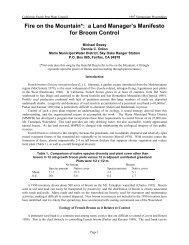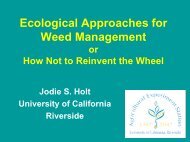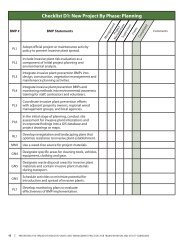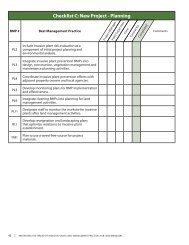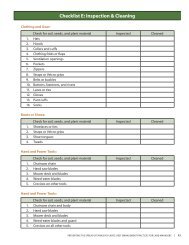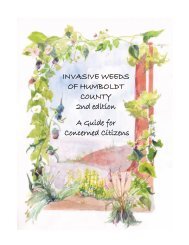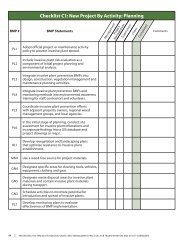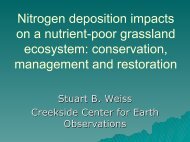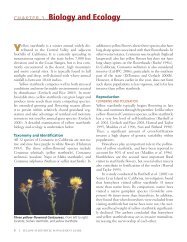Rapid evolution of invasive California poppies - Cal-IPC
Rapid evolution of invasive California poppies - Cal-IPC
Rapid evolution of invasive California poppies - Cal-IPC
You also want an ePaper? Increase the reach of your titles
YUMPU automatically turns print PDFs into web optimized ePapers that Google loves.
<strong>Rapid</strong> Evolution <strong>of</strong> Invasive<strong><strong>Cal</strong>ifornia</strong> PoppiesElizabeth LegerDepartment <strong>of</strong> Agronomy and Range ScienceUniversity <strong>of</strong> <strong><strong>Cal</strong>ifornia</strong>, Davis
<strong>Rapid</strong> <strong>evolution</strong>• e.g. herbicide resistance
<strong>Rapid</strong> <strong>evolution</strong>• e.g. herbicide resistance
<strong>Rapid</strong> <strong>evolution</strong>?• climate• disturbance regimes• insect enemies• pathogens• soil biota• interactions with new plants
<strong>Rapid</strong> <strong>evolution</strong> in the <strong><strong>Cal</strong>ifornia</strong>poppy• Increases in size <strong>of</strong> <strong>invasive</strong> <strong>poppies</strong>• Adaptation to local climate• Changes in herbivore resistance
Natural and invasion history• native to westernNorth America• <strong>invasive</strong> plants inareas withMediterraneanclimates• introduced intoChile around 1850Eschscholzia californica
Collection sites
Common gardens• 10 californian populations + 10 chilean populations• Half with competition, half without
Are <strong>invasive</strong> <strong>poppies</strong> larger andmore fit than natives?
Are <strong>invasive</strong> <strong>poppies</strong> larger andmore fit than natives?100Plant sizeWeight in grams80604020Chile<strong><strong>Cal</strong>ifornia</strong>0With NoCompetition Competition
Do <strong><strong>Cal</strong>ifornia</strong> <strong>poppies</strong>demonstrate similar clinalvariation in their native and<strong>invasive</strong> ranges?
Similar climatic gradients
Plant traitsEnvironmental traits• Plant size• Plant fecundity• Flower and seedcharacteristics• Phenology• Latitude, longitude• Elevation• Precipitation• Temperature
Plant traitsEnvironmental traits• Plant size• Plant fecundity• Flower and seedcharacteristics• Phenology• Latitude, longitude• Elevation• Precipitation• TemperaturePrinciple components that represent correlated traits
Coastal and inland gradients
Similar latitudinal gradients"size and fecundity"210-1-2-3**-2 -1 0 1 2 3"latitude and precipitation"<strong><strong>Cal</strong>ifornia</strong>nChilean* P < 0.05<strong><strong>Cal</strong>ifornia</strong>n r 2 = 0.55Chilean r 2 = 0.52
Are <strong>invasive</strong> <strong>poppies</strong> lessresistant to herbivores thannatives?
The herbivores...Cabbage looper, Trichoplusia ni• Cosmopolitan generalistTussock moth, Orgyia vetusta• Native generalist
Invasive <strong>poppies</strong> are moreresistant to herbivoresFinal caterpillar weightFinal caterpillar weightFinal weight (mg)2.01.81.6*P = 0.0085Final weight (mg)543211.4<strong><strong>Cal</strong>ifornia</strong>nChilean0<strong><strong>Cal</strong>ifornia</strong>nChileancabbage looper, Trichoplusia nitussock moth, Orgyia vetusta
Invasive <strong>poppies</strong> are:
Invasive <strong>poppies</strong> are:• Larger when grown with reducedcompetition
Invasive <strong>poppies</strong> are:• Larger when grown with reducedcompetition• Adapted to local climatic conditions
Invasive <strong>poppies</strong> are:• Larger when grown with reducedcompetition• Adapted to local climatic conditions• More resistant to herbivores than are nativeplants
AcknowledgementsDr. Kevin Rice and the entire Rice LabMatthew ForisterPaul and Clare LegerMaraya CornellFunding sources:Department <strong>of</strong> Agronomy and Range ScienceUC Davis Jastro-ShieldsUC Davis IGERT for Biological InvasionsUC Davis Botanical Society



